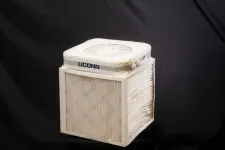(Press-News.org) The nutrients available from seafood could drop by 30 per cent for low-income countries by the end of the century due to climate change, suggests new UBC research.
That’s in a high carbon emissions and low mitigation scenario, according to the study published today in Nature Climate Change. This could be reduced to a roughly 10 per cent decline if the world were to meet the Paris Agreement targets of limiting global warming to 1.5 to 2 degrees Celsius - which recent reports have shown we’re not on track to achieve.
“Low-income countries and the global south, where seafood is central to diets and has the potential to help address malnutrition, are the hardest hit by the effects of climate change,” said first author Dr. William Cheung, professor and director of the UBC Institute for the Oceans and Fisheries (IOF). “For many, seafood is an irreplaceable and affordable source of nutrients.”
The researchers examined historical fisheries and seafood farming, or mariculture, databases including data from UBC’s Sea Around Us to find out quantities of key nutrients that were available through fisheries and seafood farming in the past, and used predictive climate models to project these into the future. They focused on four nutrients that are plentiful in seafood and important to human health: calcium, iron, protein and omega-3 fatty acids, the latter of which is not readily available in other food sources.
They found that the availability of these nutrients peaked in the 1990s and stagnated to the 2010s, despite increases provided by farming seafood, and from fishing for invertebrates such as shrimp and oysters.
Calcium sees biggest decline
Looking to the future, the availability of all four nutrients from catches is projected to decrease, with calcium the hardest hit at a projected decline of about 15 to 40 per cent by 2100 under a low and high emissions scenario, respectively. Omega-3 would see an approximately five to 25 per cent decrease. These declines are largely driven by decreases in the amounts of pelagic fish available for catch.
“Small pelagic fish are really rich in calcium so in areas of the world where people have intolerances to milk or where other animal-sourced foods, like meat and dairy, are much more expensive, fish is really key to people’s diets,” said senior author Dr. Christina Hicks, professor at Lancaster University. “In many parts of the world, particularly low-income countries across the tropics, fish supply nutrients that are lacking in people's diets.”
While seafood farming will contribute more nutrients in the future compared with current levels, the researchers projected these increases would not be able to compensate for the loss from fisheries. Under a high emissions scenario, any gains in the availability of nutrients from seafood farming before 2050 would be lost by 2100.
“The primary reason for this is climate change, which is also a significant threat to seafood farming, leaving us with a growing nutritional deficit,” said co-author Dr. Muhammed Oyinlola, a postdoctoral fellow in the UBC department of zoology and the Institut national de la recherche scientifique. “Seafood farming alone cannot provide a comprehensive solution to this complex issue.”
The availability of all four nutrients from tropical waters of generally lower income nations, such as Indonesia, the Solomon Islands and Sierra Leone, is projected to decline steeply by the end of the century under a high emissions scenario, compared with minimal declines in higher income, non-tropical waters, such as those of Canada, the U.S. and the U.K.
Globally, the researchers projected that seafood-sourced nutrient availability would decrease by about four to seven per cent per degree Celsius warming. For lower-income countries across the tropics including Nigeria, Sierra Leone, and the Solomon Islands, the projected decline was two to three times this global average at nearly 10 to 12 per cent per unit of warming.
“This research highlights the impact of every degree of warming,” said Dr. Cheung. “The more we can reduce warming, the fewer risks to marine and human life.”
Using all of a fish
Certain types of fish such as anchovies and herring are packed with nutrients but often used for fish meal and fish oil because these nutrients also promote fish growth. Similarly, many countries retain only select parts of a fish for sale. The researchers highlighted potential adaptations to increase nutrient availability from seafood, by retaining more of these nutritious fish for local human consumption, as well as reducing food waste in fisheries production and consumption by using all parts of a fish including the head and fins.
“The future development of seafood supply needs to consider the nutritional security of vulnerable groups, not just economic benefit,” said Dr. Cheung. “But there’s a limit to how effective these interventions are, so it’s important to limit global warming as much as possible.”
END
Low-income countries could lose 30% of nutrients like protein and omega-3 from seafood due to climate change
2023-10-30
ELSE PRESS RELEASES FROM THIS DATE:
Dong engineering spatial wood carbon scaffolds with nanocellulose fillers for water deionization
2023-10-30
Pei Dong, Assistant Professor, Mechanical Engineering, received $250,000 from the U.S. Department of the Interior for the project: "Engineering Spatial Wood Carbon Scaffolds with Nanocellulose Fillers for Water Deionization." This funding began in Sept. 2023 and will end in Sept. 2025.
This project seeks to create an innovative and energy-efficient capacitive deionization process with the help of biomass-based advanced porous structures for water desalination and purification.
###
About George Mason University
George Mason University is Virginia's largest public research university. Located near Washington, D.C., Mason enrolls 38,000 students from 130 countries ...
Gilleaudeau conducting geochemical analysis of carboniferous carbonates & implications for ocean oxygenation
2023-10-30
Geoffrey Gilleaudeau, Assistant Professor, Atmospheric, Oceanic and Earth Sciences (AOES), received funding for the project: "Geochemical Analysis of Carboniferous Carbonates and Implications for Ocean Oxygenation."
He and his collaborators aim to generate a new composite carbon record through the lower Mississippian in the Williston Basin. They also aim to generate a new record that tests the hypothesis that carbon excursion was related to an expansion of global ocean anoxia, ...
Russell studying Black displacement & mobility in Arlington County
2023-10-30
Russell Studying Black Displacement & Mobility In Arlington County
Donald Russell, Director, Provisions Research Center for Art & Social Change, Director, Mason Exhibitions, University Curator, College of Visual and Performing Arts (CVPA), received funding for the project: "Black Displacement and Mobility in Arlington County."
The goal of the project is to create a database of researched information that evidences Black displacement, migration, mobility, and the legacy of the Black diaspora that remains today in Arlington County.
The database will consist of maps, ...
New species of mosasaur named for Norse sea serpent
2023-10-30
Scientists have discovered a new species of mosasaur, large, carnivorous aquatic lizards that lived during the late Cretaceous. With “transitional” traits that place it between two well-known mosasaurs, the new species is named after a sea serpent in Norse mythology, Jormungandr, and the small North Dakota city Walhalla near to where the fossil was found. Details describing Jǫrmungandr walhallaensis are published today in the Bulletin of the American Museum of Natural History.
“If you put flippers on a Komodo dragon and made it really big, that’s basically what it would have looked like,” said the study’s lead ...
NSF funds holistic approach to help farmers adapt to climate change
2023-10-30
The National Science Foundation (NSF) awarded Emily Burchfield, Emory assistant professor of environmental sciences, $1.6 million to lead efforts to identify emerging pressures on agriculture in Georgia, Iowa and Ohio and to develop predictive models to help farmers and policymakers weather these changes.
“In a nutshell, we’re trying to understand what climate change will mean for agriculture in these three states,” Burchfield says. “We’ll be integrating biophysical projections based on environmental data with insights ...
University of Cincinnati study: ‘GPS’ seed devices effective in localizing breast tumors
2023-10-30
University of Cincinnati Cancer Center researchers found a seed device that acts as a GPS for surgeons to locate and remove breast and lymph node tumors was safe and effective.
The feasibility study evaluating the use of the devices, called SmartClips, was recently published in the journal The American Surgeon.
UC’s Jaime Lewis and her colleague Elizabeth Shaughnessy helped test the SmartClip devices as they were being developed.
“We went a few times and saw the different prototypes, worked with them, and provided feedback. ...
Researchers studying children’s health related to chemical exposures
2023-10-30
OKLAHOMA CITY, OKLA. – OU researchers have received a $1.8 million grant from the U.S. Environmental Protection Agency to establish a research center to address children’s cumulative health impacts from agricultural and non-chemical exposures. This grant will create the Children’s Environmental Health Center in the U.S. Southern Great Plains, which includes Oklahoma and Texas. The Center will focus on mitigating the chemical and non-chemical stressors that affect school absenteeism caused by gastrointestinal and respiratory diseases.
This collaborative center will be under the direction of Changjie Cai, Ph.D., assistant professor ...
EPA testing shows the power of D-I-Y air filters to trap viruses
2023-10-30
There is a low-cost way for you to protect yourself and reduce your risk of respiratory diseases such as flu, RSV, and COVID-19. Build yourself a Corsi-Rosenthal box (CR box) in 30 minutes with just $60 worth of common hardware store supplies.
In July, U.S. Environmental Protection Agency scientists began several weeks of advanced bioaerosol chamber testing to assess the efficacy and power of this air filter against infectious aerosols, like the virus that causes COVID-19. The results are in, and they are good.
The U.S. EPA Office of Research and Development’s 3,000 cubic ft. bioaerosol chamber testing results show ...
Year-by-year blood pressure variability from midlife to death and lifetime dementia risk
2023-10-30
About The Study: High blood pressure variability indicated increased lifetime dementia risk in late life but not in midlife in this study that included 820 adults monitored for an average time of 32 years. This result suggests that high blood pressure variability may indicate increased dementia risk in older age but might be less viable as a midlife dementia prevention target.
Authors: Jan Willem van Dalen, Ph.D., of the Radboud University Medical Center in Nijmegen, the Netherlands, is the corresponding author.
To access the embargoed study: Visit our For The Media website at this link https://media.jamanetwork.com/
(doi:10.1001/jamanetworkopen.2023.40249)
Editor’s ...
Sociodemographic disparities and hearing-related quality of life in children with hearing loss
2023-10-30
About The Study: The findings of this study suggest that race and ethnicity and neighborhood disadvantage are associated with hearing-related quality of life in deaf or hard-of-hearing children. The neighborhood association was seen most broadly in children older than 13 years.
Authors: Dylan K. Chan, M.D., Ph.D., of the University of California, San Francisco, is the corresponding author.
To access the embargoed study: Visit our For The Media website at this link https://media.jamanetwork.com/
(doi:10.1001/jamanetworkopen.2023.40934)
Editor’s Note: Please see ...



